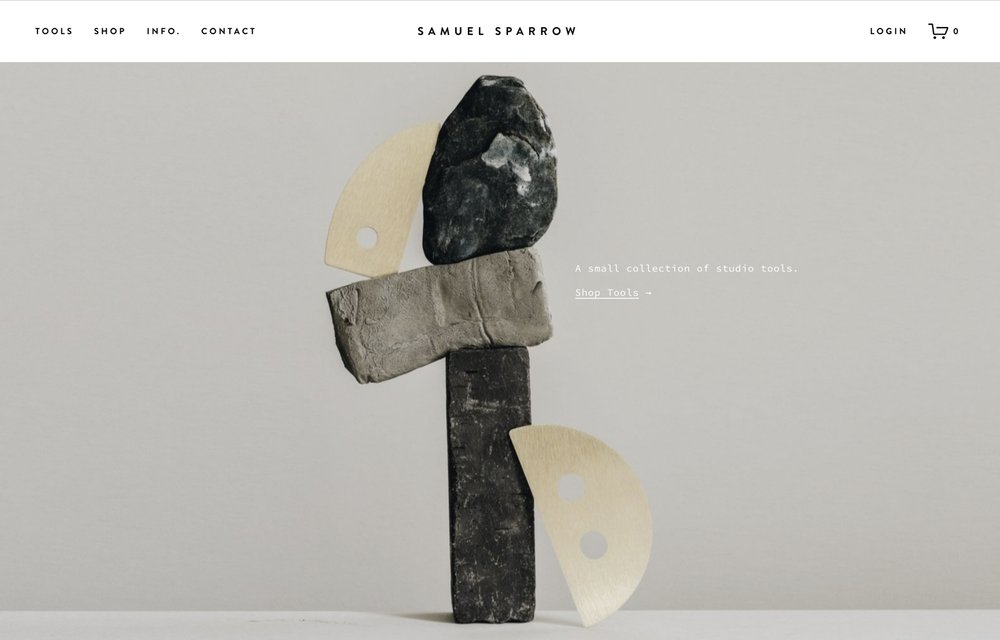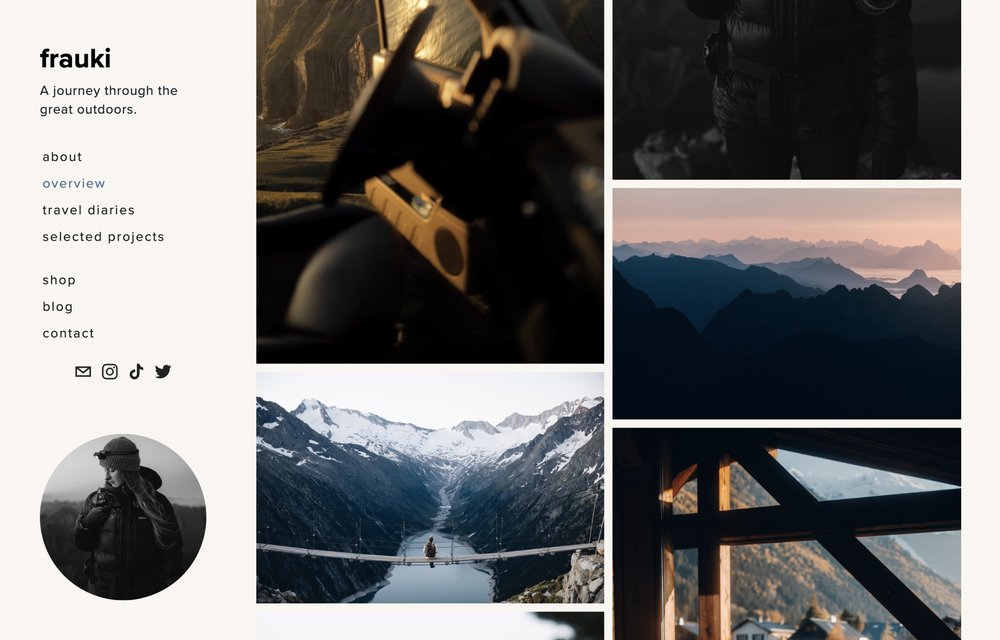Download our free guide to creating a photography website and start sharing your work online.
The email you entered is invalid.
Thank you for subscribing.
By entering your email, you indicate that you have read and understood our Privacy Policy and agree to receive marketing from Squarespace.
Designing a website as a creative entrepreneur means juggling a few priorities. The web design has to reflect your artistic brand clearly, you need to choose the best work to display, and then decide how your website fits into your online presence and overall business strategy.
We dove into those topics with three artists on Squarespace:
Gunnar Freyr, photographer and entrepreneur
Frauke Hameister, photographer and creative
Samuel Sparrow, potter and maker
Learn how these three creatives choose which work to share on their website, how they designed an online home that reflects their work and aesthetic, and how their respective websites have helped them grow their full-time creative careers.
Choosing what work to share on your website
Creatives serve multiple audiences with their online presence. They want to show their work in a way that’s representative of their artistic vision while engaging a general audience, in addition to fans, peers, and potential collaborators or brand partners.
Each of the three creatives focus on a different part of the viewer’s experience when choosing what work to feature on their own website. Gunnar, for example, tries to offer variety while staying true to his work.
“Most of my website audience comes from social media. Therefore, I try not to have it overlap too much with what I am showing on my social media,” he says. “My focus is on keeping it relevant to the kind of work I want to engage in and some of the work I am most proud of. I feel this will be relevant both for my fans and potential clients, as well as newcomers.”
“My focus is on keeping it relevant to the kind of work I want to engage in and some of the work I am most proud of.”
Frauke films and photographs her travels in nature, often in the mountains. She similarly keeps her audience in mind when deciding what to put on her website, but her focus is the emotional effect of what she puts on her homepage.
“When people enter my website, I want them to get lost in that little moment right away,” she says. “I want whoever ends up on the website—a nature lover and outdoor enthusiast, a returning customer, a potential client or newbie to the great outdoors—to want to spend time on the website and eventually leave in awe about our natural world and what it has to offer.”
For Samuel, who sells physical products to a global audience, it’s important to get the details right. “I realized early that visitors are often committing to buy my work without ever seeing or holding it in real life,” he says. “Therefore, it’s very important to me that my images accurately reflect the color and texture of the clay and glaze I use to make my finished pots, giving new followers the confidence to buy my work.”
Designing a website for your creative brand
In addition to the work itself, a creative’s website design is part of the full package that represents them online. The three Squarespace entrepreneurs we spoke with all highlighted color as a key part of creating a cohesive visual design.
“Color palette is one of the most important things to flow through a website,” Frauke says. “I am currently working on exactly that part of my website.” Samuel and Gunnar both use their work to inspire their website color palettes.
“The color palette is inspired by the colors found in my images and in Icelandic nature,” Gunnar says. “In that way, there is a really nice cohesiveness between imagery, layout, and graphics.”
“I hope that the qualities of my work are conveyed and amplified through the design choices I’ve made for my site,” Samuel adds. “The background color references the clay I use when it's fired.”
“Color palette is one of the most important things to flow through a website.”
Customizable page layouts also help the three artists to highlight specific parts of their business. For Samuel, for example, “The layout is designed to make a distinction between the two elements of my business—Tools and Pots.”
Gunnar also keeps page layout top of mind, especially as he’s redesigning his website. “What has been a key part of the layout for my old site as well as the new is the focus on my imagery,” he says. “Further, the layout has to ensure that the content can be enjoyed in an easy and fluid manner.”
Frauke optimized her homepage layout to bring out the immersive experience she hopes to create with her website. “I recently added little videos on the homepage of my website as some sort of introduction into what I do and how I travel,” she says. The videos give website visitors the view from her camper and into the mountains, offering a teaser of both her artistic style and a day in her life.
Using a website to grow a creative business
Samuel, Frauke, and Gunnar also credit their websites for opening up new opportunities in their creative careers. Each cited their website as a way to find and engage with clients or customers, or to explore new revenue streams branching off of their artistic work.
“I wouldn’t have a business if it wasn’t for my Squarespace website,” says Samuel. “From day one Squarespace has empowered me to showcase my work, enabling me to grow what was a side project into a full time business. From my studio in rural Scotland I’ve been able to reach and sell my work to a global audience.”
A website “definitely played a huge part in my career,” Frauke adds. “When a potential new client asks for examples of recent work I usually send them over to my website. I also sell presets, which helps to generate another stream of income. That helps me afford my travels, which then leads to providing more content and resources for my followers.”
“I wouldn’t have a business if it wasn’t for my Squarespace website.”
“My website and my social media are the two most important elements of my business model,” says Gunnar. “Social media is where I catch people’s attention and my website is where I show them what I can do and have to offer.”
“Nowadays, I am increasingly moving into a direction of building digital assets that I can monetize,” he adds. “My website will be the main place where I present and distribute these things.”
Must-have website features for creative entrepreneurs
Since every entrepreneur and creative has different needs, we asked the three creatives what website features feel essential for their business. The responses ranged from website management to ecommerce tools, but had one main theme: all-in-one convenience that gives them time and freedom to focus on creating.
“The Squarespace app. I feel like we are moving more and more towards a world where you don’t necessarily sit on your laptop anymore, but where your phone plays such a big role,” says Frauke. “To be able to work on my website while I am traveling is one of the most helpful features that I do not want to live without anymore.”
“My site is an extension of my studio. As a one-person brand it's important that I can rely on a platform to perform and manage a number of tasks,” Samuel says. “I’m able to make quick design changes to reflect my brand, track my inventory, and process orders. It allows me to focus on building my studio and do what I’m good at: making.”
“It allows me to focus on the things that I do best: creating and sharing.”
“One of the most powerful tools is the ability to establish and build a mailing list,” he adds. “It’s proven to be a powerful way to tell my story, talk about my journey, and update subscribers about studio news and shop updates.”
Gunnar has a similar perspective. “I love having a ‘one-stop-shop’ where I can consolidate everything,” he says. “Part of the one-stop-shop is the ability to do some really cool integrations. For example, I have a print shop integration on my website where print orders are automatically sent directly to the clients. From order to shipment, it’s all processed automatically. I think this is really amazing and it allows me to focus on the things that I do best: creating and sharing.”
Ready to build your own brand on Squarespace?






